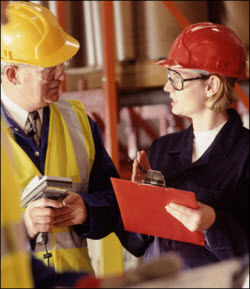
International commerce is booming, and with it comes the need for safety management across borders. Today, even small businesses are likely to have customers and suppliers in foreign countries. Keep reading to learn how one international corporation is making sure that worker protection doesn’t fall through the cracks.
Tate & Lyle is a British-based global specialty food ingredients business with production facilities and research centers throughout the Americas, Europe, and Southeast Asia. The company’s operating philosophy is, “We always put safety first; nothing is more important.”
To enhance safety performance across geographic boundaries Tate & Lyle has introduced a requirement for a “permit to work” that spells out risks and safety requirements for all non-routine jobs. The permit (not to be confused with a document that allows an employee to work legally in the United States) is commonly used in Britain and Europe.
Standard operating procedures cover safety requirements for routine tasks. The permit program, which affects company employees as well as contractors, was developed to protect workers who perform nonroutine work (maintenance jobs, painting, hot work, excavations, confined space work, etc.).
The permit is issued by an individual known as an “area responsible person” (ARP). This can be an operator, technician, or member of management responsible for a particular work area. When a request comes in for a permit to work, the ARP and the individual requesting it visit the worksite together. They perform a hazard assessment and determine the need for personal protective equipment (PPE), other safety equipment, safety activities, additional permits, and any other precautions.
The ARP signs the permit and adds his or her contact information. This ensures that the employees can be in touch with any questions as they perform the work. Every employee on the project is also required to sign the permit. It’s the job of the ARP to monitor the area to determine if conditions change during the job.
The system has a number of built-in checks and balances. For example, an individual cannot issue a work permit for him- or herself. Also, each work permit has a unique identifying number; the same number is transcribed on any other required permits. The document identifies other types of permits that must be obtained, such as hot work or confined space.
Benefits of a permit-to-work program
While the permit system has been generally well received, Tate & Lyle safety officials report some pushback by employees who questioned why another piece of paper was needed. This concern is generally dispelled once workers understand the value of the permit system.
One benefit is that it brings contractor teams together. Without the document and process, one contractor’s work could conceivably create hazards for another contractor. For example, if a metal fabricator is working in a confined space alongside a welder, the permit gives both tradespeople the peace of mind that work will be performed safely with all hazards identified and addressed.
The permit-to-work strategy also provides accountability. In the past, Contractor A might be hesitant to inform Contractor B if he or she believed a task was being done unsafely. The permit gets contractors and employees on the same page and fully aware of the hazards.
One challenge of the rollout has been avoiding a backlog of those seeking permits from a single area responsible person. One solution is having contractors start on a staggered schedule to give the ARP the time required to prepare permits without contractors having to wait in line. Tate & Lyle is also considering an electronic version of the work permits.